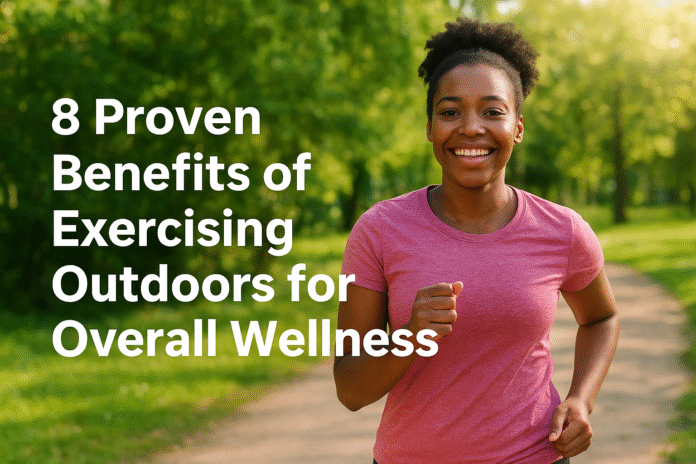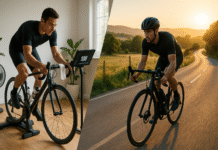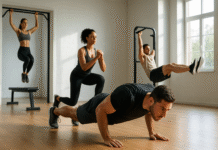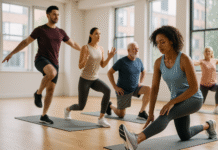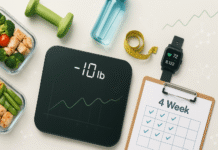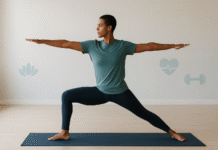Exercising outdoors is more than a mood-boosting pastime — it combines movement with fresh air, daylight, natural scenery, and sensory variety in ways that change how your body and mind respond to activity. In the first 100 words of this article you’ll see the primary topic clearly: outdoor exercise (walking, running, cycling, bodyweight routines, hiking, and green workouts) can improve mental health, sleep, physical fitness, vitamin D status, immune function, motivation, social connection, and functional capacity.
Disclaimer: This article offers practical, evidence-informed guidance but does not replace personalized medical, psychiatric, or exercise prescription. If you have chronic health conditions, are pregnant, recovering from injury, or are unsure about starting a new exercise program, consult a qualified healthcare professional before beginning.
What you’ll learn and who this is for: If you want an actionable, step-by-step guide to why outdoor exercise works and how to do it safely and effectively — whether you’re a beginner, a busy professional, a parent, or a fitness-focused adult — this article gives practical plans, safety checks, warm-ups, progressions, a 4-week starter plan, troubleshooting, and evidence-backed explanations.
Key takeaways
- Outdoor workouts combine physical movement with daylight and nature to boost mood, motivation, and sleep.
- Sunlight exposure during outdoor activity supports vitamin D production, which affects bone and immune health when balanced safely.
- Natural settings may enhance immune markers and enjoyment compared with indoor exercise, improving long-term adherence.
- Simple, low-cost outdoor routines (walking, stair intervals, bodyweight circuits) can be scaled for any fitness level.
- A practical 4-week plan, warm-up checklist, and safety notes make it easy to start and progress without equipment.
1. Better mental health: reduced stress, anxiety, and depression
What it is and core benefits
When you exercise outdoors — especially in green spaces or natural settings — you combine the known psychological benefits of exercise with restorative effects of nature. This can mean faster mood improvement after a single session and measurable reductions in symptoms of stress, anxiety, and mild-to-moderate depression over repeated sessions.
Evidence snapshot
Systematic reviews and meta-analyses of “green exercise” and nature-based interventions show consistent improvements in mood, reductions in anxiety, and better affective responses compared with non-nature settings for many people.
Requirements / prerequisites and low-cost alternatives
- Equipment: Minimal — comfortable shoes, weather-appropriate clothes.
- Skills: Basic walking or gentle jogging; no special skills required.
- Cost: Free to low cost (public parks, trails).
- Low-cost alternatives: Urban pocket parks, tree-lined streets, rooftop gardens, or even a balcony can provide some nature exposure if large parks are inaccessible.
Step-by-step implementation (beginner)
- Choose a nearby green spot (park, riverside, tree-lined street).
- Start with a 10–15 minute brisk walk at a pace where you can speak in short sentences but feel your heart rate rise.
- Add mindful focus: notice three things you can see, two you can hear, and one you can smell to deepen nature engagement.
- End with 3 minutes of slow walking and gentle breathing.
Beginner modifications and progressions
- Simplify: If 15 minutes feels hard, begin with 5–8 minutes and increase by 2–3 minutes daily.
- Progress: Increase duration to 30–45 minutes and add short intervals (30–60 sec faster pace) twice per session.
Recommended frequency / duration / metrics
- Frequency: 3–5 days per week.
- Duration: 15–60 minutes per session depending on goals.
- Metrics: Mood rating before/after (1–10), perceived stress scale, session count per week.
Safety, caveats, common mistakes
- Don’t force intensity for the sake of “more nature” — higher intensity may reduce restorative benefits for beginners.
- Watch weather and terrain to avoid slips or overexertion.
- Caveat: Severe depression/anxiety requires clinical care; outdoor exercise can complement but not replace professional treatment.
Mini-plan (2–3 steps)
- Week 1, Day A: 15-min brisk walk in a park + 2-minute breathing cool-down.
- Week 1, Day B: 10-min walk with mindful sensory check (3–2–1) + 5-min gentle stretching.
Evidence references for this section.
2. Sunlight and vitamin D synthesis (bone and immune support)
What it is and core benefits
Sunlight, specifically UVB radiation, triggers vitamin D production in skin. Adequate vitamin D supports bone mineralization, musculoskeletal function, and plays roles in immune regulation. Outdoor exercise offers a practical way to get short, safe sun exposure alongside movement.
Requirements / prerequisites and low-cost alternatives
- Equipment: No special gear; sunglasses and sunscreen available.
- Skills: Awareness of safe sun timing and exposure.
- Cost: Free. Supplements are an alternative when sun exposure is inadequate or contraindicated.
Step-by-step implementation (beginner)
- Time it right: Aim for short exposures (10–30 minutes depending on skin tone, local UV index, and clothing) to exposed areas like forearms and lower legs.
- Combine with light exercise: brisk walking or cycling during mid-morning or late afternoon.
- Balance sun and skin protection: avoid prolonged unprotected exposure at peak UV hours; use sunscreen or cover-up for longer sessions.
Beginner modifications and progressions
- Simplify: Start with 10 minutes of morning sun during a walk.
- Progress: Gradually increase time outdoors while practicing skin safety; consider supplementing with oral vitamin D if needed.
Recommended frequency / duration / metrics
- Frequency: Several short exposures per week (e.g., 3–5), not prolonged daily unprotected sun.
- Metrics: Track mood and energy; if testing vitamin D levels is needed, consult a clinician for a blood test.
Safety, caveats, common mistakes
- Sunburn risk: Don’t aim for tanning; avoid sunburn to lower skin cancer risk.
- Medication interactions: Some medicines increase sun sensitivity — check with a clinician.
- Caveat: In high-latitude or winter months, sunlight may be insufficient and supplementation might be necessary.
Mini-plan (2–3 steps)
- Morning routine: 10–15 minute walk between 8–10 a.m. with forearms lightly exposed.
- Combine with a 10-minute bodyweight core routine in a sunny spot twice weekly.
Evidence references for this section.
3. Improved sleep and circadian regulation
What it is and core benefits
Daylight exposure helps entrain (set) the circadian clock, promoting earlier and deeper sleep at night. Physical activity itself improves sleep quality; combined with morning or midday outdoor light, gains can be amplified.
Requirements / prerequisites and low-cost alternatives
- Equipment: None. Sunglasses for comfort as needed.
- Skills: Timing exercise appropriately (morning/daytime exposure is better for sleep timing than late-night bright light).
- Cost: Free.
Step-by-step implementation (beginner)
- Morning light + movement: Aim for 20–30 minutes outdoors before late afternoon to support circadian alignment.
- Avoid stimulating late-night bright light and vigorous outdoor exercise within 1–2 hours of bedtime if it seems to disturb sleep.
- Track sleep: use a simple sleep log to monitor bedtime, wake time, and perceived sleep quality.
Beginner modifications and progressions
- Simplify: Start with a 15-minute morning walk.
- Progress: Shift to 30–45 minutes of outdoor activity 4–5 times a week.
Recommended frequency / duration / metrics
- Frequency: Daily light exposure is ideal; exercise 3–5 times weekly.
- Metrics: Sleep onset latency, number of nocturnal awakenings, and subjective sleep quality.
Safety, caveats, common mistakes
- Timing matters: Late evening bright light (or intense late workouts) can delay sleep in some people.
- Caveat: Night-shift workers have different needs and should seek tailored strategies.
Mini-plan (2–3 steps)
- Daily: 20-minute morning walk before 9 a.m. for 4 weeks.
- Evening: Gentle 10-minute walk after dinner (low intensity) if desired, but avoid high-intensity late workouts.
Evidence references for this section.
4. Stronger immune response and lower inflammation (nature-linked boosts)
What it is and core benefits
Certain natural environments (forests and green spaces) have been associated with measurable changes in immune markers — for example, increases in natural killer (NK) cell activity after forest visits in controlled studies. Regular moderate outdoor activity is also associated with lower markers of chronic inflammation in population studies.
Requirements / prerequisites and low-cost alternatives
- Equipment: Comfortable clothing/shoes.
- Skills: Basic navigation and trail awareness if visiting forests.
- Cost: Low; some organized “forest bathing” programs cost money, but self-guided visits are free.
Step-by-step implementation (beginner)
- Plan a short forest or park visit of 60–120 minutes that includes walking at a comfortable pace and time for sitting or mindful observation.
- Minimize distractions: put phone on silent to maximize immersive exposure.
- Hydrate and rest as needed.
Beginner modifications and progressions
- Simplify: Start with 30–45 minutes in an urban park.
- Progress: Increase frequency or session length; add gentle bodyweight exercises on natural surfaces.
Recommended frequency / duration / metrics
- Frequency: Weekly visits of 60–120 minutes showed effects in multiple studies; even shorter, regular sessions (20–90 minutes) can be beneficial.
- Metrics: Self-reported stress scores, frequency of upper respiratory infections, or biomarkers if clinically monitored.
Safety, caveats, common mistakes
- Allergies: Tree pollen and mold can exacerbate allergies or asthma — plan timing accordingly.
- Ticks and insect safety: Use repellents, check for ticks after forest visits.
- Caveat: While immune marker changes are promising, they are one piece of a broader health picture.
Mini-plan (2–3 steps)
- Weekly: 60-minute walk in a nearby forest or large park with 10 minutes of seated mindfulness.
- Supplement: Two shorter 20–30 minute green walks midweek for ongoing benefits.
Evidence references for this section. Oncotarget
5. Greater enjoyment and exercise adherence
What it is and core benefits
People often find outdoor sessions more enjoyable than indoor workouts. Increased enjoyment predicts greater long-term adherence — the single most important factor for sustained fitness gains.
Requirements / prerequisites and low-cost alternatives
- Equipment: Minimal; a map or app if exploring new routes.
- Skills: Basic route planning and safety awareness.
- Cost: Free for most outdoor settings.
Step-by-step implementation (beginner)
- Pick an activity you like (walking, cycling, easy trail running, or outdoor yoga).
- Set a simple habit anchor: same time of day, same route to build routine.
- Log sessions: record time, duration, enjoyment level (1–10).
Beginner modifications and progressions
- Simplify: Begin with a twice-weekly 20-minute outdoor session.
- Progress: Add one extra session each week or gradually increase duration.
Recommended frequency / duration / metrics
- Frequency: Aim for at least 3 sessions per week to build a habit.
- Metrics: Adherence rate (sessions completed / sessions planned), self-reported enjoyment.
Safety, caveats, common mistakes
- Overreliance on novelty: New scenic routes are motivating, but consistency matters more than constant novelty.
- Caveat: For some, outdoor discomforts (weather, bugs) can reduce enjoyment — plan for contingencies.
Mini-plan (2–3 steps)
- Habit anchor: 20-minute morning park walk every Monday, Wednesday, Friday.
- Track: Rate enjoyment after each session; aim to increase average enjoyment within 4 weeks.
Evidence references for this section.
6. Improved functional fitness and calorie burn (terrain and variety)
What it is and core benefits
Uneven ground, slopes, wind resistance, and natural obstacles make outdoor movement more functionally demanding — engaging stabilizer muscles and improving balance, proprioception, and calorie expenditure beyond steady indoor treadmill workouts.
Requirements / prerequisites and low-cost alternatives
- Equipment: Supportive footwear and optional trekking poles for steep terrain.
- Skills: Basic balance and coordination. Walk before hiking; practice stairs.
- Cost: Low — trails and parks typically free.
Step-by-step implementation (beginner)
- Begin on gentle trails or grassy fields to build ankle stability.
- Incorporate short hill repeats or stair intervals: walk briskly uphill for 30–60 seconds, recover on the descent.
- Add bodyweight exercises on a park bench (step-ups, incline push-ups) to boost strength.
Beginner modifications and progressions
- Simplify: Start with flat 20–30 minute walks.
- Progress: Add 1–2 hill intervals or add a 10-minute bodyweight circuit twice weekly.
Recommended frequency / duration / metrics
- Frequency: 2–4 times weekly for mixed cardio and functional work.
- Metrics: Stair/step count, time to climb a local hill, perceived exertion, activity minutes.
Safety, caveats, common mistakes
- Trip hazards: Watch roots and rocks. Slow your pace if footing is poor.
- Overuse: Quickly increasing trail distance can trigger shin splints or tendon pain.
Mini-plan (2–3 steps)
- Week 1: 25-minute trail walk with 3 slow uphill bursts (30–45 sec).
- Week 2: Add a 10-minute park bench circuit after the walk twice weekly.
Evidence references for this section.
7. Social connection and community wellbeing
What it is and core benefits
Group outdoor activities — walking groups, community bike rides, outdoor fitness classes — strengthen social ties, increase accountability, and elevate mental wellbeing. Social exercise enhances motivation and can make activity a sustainable part of life.
Requirements / prerequisites and low-cost alternatives
- Equipment: None beyond activity-appropriate gear.
- Skills: Basic social etiquette for group activities.
- Cost: Often free or low-cost; community-organized groups often welcome beginners.
Step-by-step implementation (beginner)
- Find a local group or start with a friend — many parks have meetups or informal walking groups.
- Agree on a reasonable pace and a short meeting time (20–30 minutes).
- Make it social first: chat and walk; solid habits form from the social interaction as much as the exercise.
Beginner modifications and progressions
- Simplify: Invite one friend for weekly outdoor walks.
- Progress: Join a larger group once comfortable.
Recommended frequency / duration / metrics
- Frequency: Weekly social outdoor meetups plus independent sessions.
- Metrics: Number of social sessions per month, reported social connectedness.
Safety, caveats, common mistakes
- Mismatch of pace or goals can reduce enjoyment — choose groups with similar energy levels.
- Caveat: Some group settings require basic skills (e.g., cycling in a pack).
Mini-plan (2–3 steps)
- Start: Invite a friend for a 30-minute weekend park walk.
- Scale: Join a community walking group after two weeks.
Evidence references for this section.
8. Opportunity for varied workouts and skill development (balance, mobility, creativity)
What it is and core benefits
Outdoor spaces invite creativity: dynamic warm-ups on grass, mobility flows on benches, plyometrics on soft ground, or interval hill sprints. This variety builds balance, coordination, and mobility — skills often neglected in gym-only routines.
Requirements / prerequisites and low-cost alternatives
- Equipment: Optional: yoga mat, resistance band, small set of dumbbells; none required.
- Skills: Ability to perform basic bodyweight moves safely.
- Cost: Low or free.
Step-by-step implementation (beginner)
- Select a safe flat area (grassy patch) for mobility and bodyweight work.
- Sample 15-minute outdoor mobility flow: ankle circles, hip openers, shoulder rolls, and 3 rounds of bodyweight squats and lunges.
- Add skill practice: balance drills (single-leg stand with eyes open) 2–3 times per session.
Beginner modifications and progressions
- Simplify: Begin with mobility only, then add strength moves.
- Progress: Increase reps, add unilateral (single-leg) exercises, or include short plyometric elements when ready.
Recommended frequency / duration / metrics
- Frequency: 2–3 mobility/skill sessions weekly + cardio sessions.
- Metrics: Balance hold time, mobility range (e.g., squat depth), perceived ease of movement.
Safety, caveats, common mistakes
- Surface: Avoid hard or uneven surfaces for high-impact jumps.
- Form over flair: Prioritize controlled movements to avoid injury.
Mini-plan (2–3 steps)
- 3x/week: 15-minute mobility and balance session on grass; finish with a 10-minute brisk walk.
- Week 3: Add 2 sets of 8–12 single-leg step-ups onto a low park bench.
Evidence references for this section. Taylor & Francis Online
Quick-start checklist and warm-up (for every outdoor session)
Quick-start checklist
- Weather check (temperature, precipitation, air quality)
- Appropriate clothing (layers for variable weather)
- Supportive shoes with good traction
- Water bottle and small snack if session >60 minutes
- Phone, ID, and local emergency contact info
- Sunscreen and hat for sunny days
- Small first-aid items (band-aids, blister tape) for longer hikes
Five-minute dynamic warm-up
- Ankle circles — 30 seconds each side.
- Walking lunges (slow) — 10 steps each leg.
- Arm swings/circles — 30 seconds.
- High-knee march or light jog — 60 seconds.
- Hip openers (leg swings) — 10 each side.
Troubleshooting and common pitfalls
Problem: I don’t feel motivated to go outside.
Fix: Anchor the activity to an existing habit (e.g., after morning coffee), set a 5-minute minimum threshold, and invite a friend.
Problem: Weather is bad — too hot, cold, or rainy.
Fix: Have a fallback plan (covered walkways, indoor bodyweight routine) and learn quick layering strategies for heat and cold.
Problem: Routes feel boring.
Fix: Use interval formats, audiobooks, or explore new micro-routes every few days.
Problem: Allergies flare up outdoors.
Fix: Check pollen forecasts, choose lower-pollen times (after rain), and bring antihistamines if recommended by your clinician.
Problem: Safety concerns about routes at night.
Fix: Choose well-lit routes, bring a buddy, or shift to daytime sessions.
How to measure progress and results
- Behavioral metrics: Sessions per week, total minutes of activity, streaks.
- Performance metrics: Time to walk/run a route, number of hill repeats, number of bodyweight reps.
- Wellbeing metrics: Pre/post-session mood ratings (1–10), sleep quality scores, stress ratings.
- Health metrics: If clinically indicated, track resting heart rate, blood pressure, or lab measures (e.g., vitamin D levels) with your clinician.
4-Week Starter Plan: outdoor-friendly and beginner-focused
Goal: Build a consistent outdoor routine that improves mood, sleep, and baseline fitness.
Week 1 — Habit foundation
- Mon: 15-min brisk walk (morning) + 3-min breathing cool-down.
- Wed: 15-min mobility & balance session on grass.
- Sat: 25-min scenic walk (easy pace).
Week 2 — Add variety
- Mon: 20-min brisk walk + 3 short hill/stair bursts (30 sec)
- Wed: 15-min mobility + 2 sets of 8 step-ups on bench
- Fri: 20-min walk with mindful 5-minute sensory check
- Sun: 30-min leisure ride/walk
Week 3 — Build duration
- Tue: 30-min walk with 5 x 60-sec faster intervals (recover between)
- Thu: 20-min mobility + light bodyweight circuit (2 rounds: 10 squats, 8 push-ups, 12 glute bridges)
- Sat: 45-min moderate trail walk
Week 4 — Consolidate & reflect
- Mon: 30-min brisk walk + 10-min stretching
- Wed: 20-min mobility + balance progression (single-leg holds 30 sec)
- Fri: 30-min walk or cycle with friend
- Sun: 60-minute green space visit with 10 minutes seated mindfulness
Progress checks at end of weeks 2 & 4: note session completion rate, mood change (average pre/post), and perceived sleep quality.
FAQs (8–12 concise answers)
- Is outdoor exercise always better than indoor exercise?
No — both have benefits. Outdoor exercise often yields extra mood, light, and variety advantages, but indoor settings can be safer or more convenient in poor weather or for high-precision training. - How much sun exposure do I need while exercising outdoors?
Short, regular exposures (about 10–30 minutes depending on skin type, season, and location) are often enough for vitamin D production; avoid prolonged unprotected sun and consult a clinician if you’re unsure. - Can outdoor exercise replace my gym strength training?
You can build significant strength with bodyweight and park-based exercises, but heavy resistance training for specific hypertrophy goals may still require gym equipment or heavier weights. - What if I live in an urban area with little green space?
Use tree-lined streets, rooftop gardens, small pocket parks, or even urban plazas. Even brief contact with urban nature or daylight helps; consider weekend trips to larger green areas. - Is exercising outdoors safe during pollen season?
If you have allergies, check pollen forecasts, choose lower-pollen times (after rain), and bring medications as advised by your clinician. - How do I avoid overheating or hypothermia when exercising outside?
Layer intelligently, hydrate, reduce intensity during extreme heat, and learn signs of heat illness and cold exposure. Shorten or reschedule sessions when conditions are severe. - Will outdoor exercise help my sleep?
Yes — daytime outdoor light plus regular physical activity often improves sleep timing and quality for many people, especially when exposure occurs earlier in the day. - How quickly will I see benefits from outdoor workouts?
Acute mood boosts often appear after a single session; measurable changes in sleep, aerobic fitness, or mood symptoms typically appear over weeks with consistent activity. - Is forest bathing necessary to get immune benefits?
Not necessary, but spending time in large green spaces has been associated with immune marker changes in studies. Regular exposure to parks and natural settings is a practical approach. - How do I stay motivated to keep outdoor exercise a habit?
Anchor it to existing routines, invite friends, vary routes and formats, track progress, and keep sessions achievable (micro-habits help).
Conclusion
Exercising outdoors is a uniquely efficient way to combine physical activity with daylight, nature, social connection, and sensory richness. Whether your priority is better mood, improved sleep, vitamin D balance, immune support, or simply finding a sustainable fitness habit, small regular steps outside can create measurable improvements. Start small, follow the warm-up and safety checks, use the 4-week plan to build momentum, and adapt progressions to your goals.
One-line CTA: Step outside today — take a 10-minute walk and notice one thing in nature you didn’t see before.
References
- Psychological benefits of outdoor physical activity in natural versus built environments: a systematic review and meta-analysis. PMC. Published 2022. https://pmc.ncbi.nlm.nih.gov/articles/PMC9544808/
- Benefits and Risks of Sun Exposure to Maintain Adequate Vitamin D3 Levels. PMC. Published 2022. https://pmc.ncbi.nlm.nih.gov/articles/PMC10239563/
- Effect of forest bathing trips on human immune function. PMC. Published 2010. https://pmc.ncbi.nlm.nih.gov/articles/PMC2793341/
- The Effects of Outdoor versus Indoor Exercise on Psychological and Physical Health: A Systematic Review. PMC. Published 2023. https://pmc.ncbi.nlm.nih.gov/articles/PMC9914639/
- Time spent in outdoor light is associated with mood, sleep, and circadian outcomes. PMC. Published 2022. https://pmc.ncbi.nlm.nih.gov/articles/PMC8892387/
- Time Spent Outdoors and Associations with Sleep, Optimism, and Physical Health. PMC. Published 2023. https://pmc.ncbi.nlm.nih.gov/articles/PMC10366917/
- Nature-based outdoor activities for mental and physical health: systematic review and meta-analysis. PMC. Published 2021. https://pmc.ncbi.nlm.nih.gov/articles/PMC8498096/
- Forest bathing enhances human natural killer activity and expression of anti-cancer proteins. PubMed / National Library of Medicine. Published 2007. https://pubmed.ncbi.nlm.nih.gov/17903349/
- Adherence to exercise and affective responses: evidence for enhanced adherence with outdoor training (postmenopausal women). PubMed. Published 2014. https://pubmed.ncbi.nlm.nih.gov/25423324/
- The Effects of Green Exercise on Physical and Mental Wellbeing. PMC. Published 2018. https://pmc.ncbi.nlm.nih.gov/articles/PMC6518264/
- Effects of light on human circadian rhythms, sleep and mood — review. PMC. Published 2019. https://pmc.ncbi.nlm.nih.gov/articles/PMC6751071/
- Association between physical activity and vitamin D concentrations: systematic review. PubMed. Published 2017. https://pubmed.ncbi.nlm.nih.gov/28876433/




























